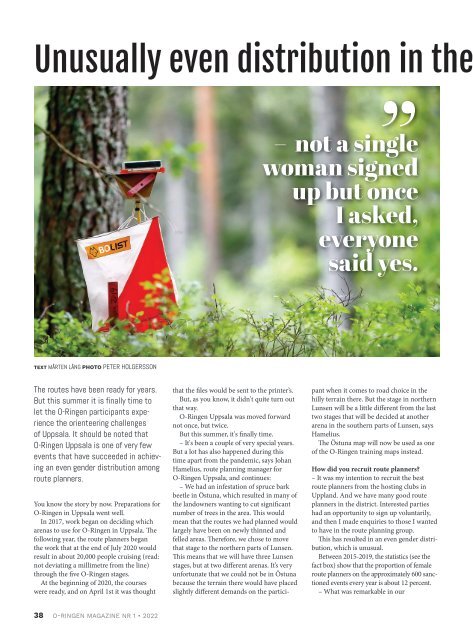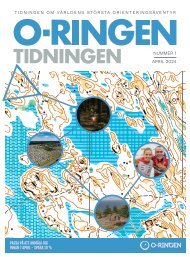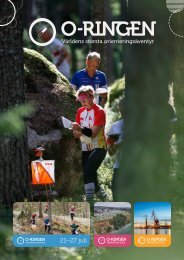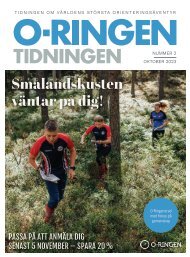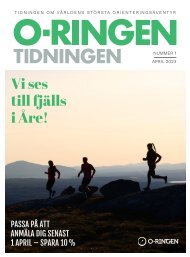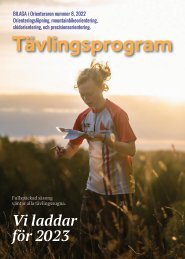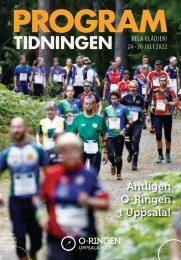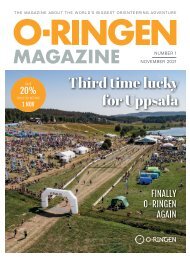O-Ringen Magazine, nr 1 - 2022
The magazine about the world's biggest orienteering adventure
The magazine about the world's biggest orienteering adventure
Create successful ePaper yourself
Turn your PDF publications into a flip-book with our unique Google optimized e-Paper software.
Unusually even distribution in the route planning<br />
» Fact FEMALE COURSE SETTERS<br />
– not a single<br />
woman signed<br />
up but once<br />
I asked,<br />
everyone<br />
said yes.<br />
Back row, from left side: Josef Nordlund, Jenny Westerberg, Mats Troeng, Magnus Blåudd, Johan Ohlström<br />
Front row: Berth-Arne Bengtsson, Helene Nilsson, Jan Troeng, Johan Hamelius, Andreas Hjertson, Dorothe Spillmann,<br />
Kate Morrison, Samantha Saeger, Fredrik Wigertz, Rob Hart, Olle Eriksson. Photo: O-<strong>Ringen</strong>.<br />
It is not only in route planning that there<br />
are clearly more men than women in the<br />
higher functionary positions within Swedish<br />
Orienteering.<br />
In the application submitted by the Swedish<br />
Orienteering Federation in 2019 for the<br />
project "More women in events", you can read,<br />
among other things:<br />
"Of the Swedish Orienteering Federation's<br />
85,000 members, 45 percent are women. For<br />
members up to the age of 50, 48 percent are<br />
women. Competition events are an important<br />
part of the federation's activities. Every year,<br />
more than 600 sanctioned events are held<br />
within the four branches of the federation.<br />
The proportion of competitive women is 40<br />
percent and, in the group, up to and including<br />
50 years of age the proportion of competitive<br />
women is 44 percent.<br />
TEXT MÅRTEN LÅNG PHOTO PETER HOLGERSSON<br />
The routes have been ready for years.<br />
But this summer it is finally time to<br />
let the O-<strong>Ringen</strong> participants experience<br />
the orienteering challenges<br />
of Uppsala. It should be noted that<br />
O-<strong>Ringen</strong> Uppsala is one of very few<br />
events that have succeeded in achieving<br />
an even gender distribution among<br />
route planners.<br />
You know the story by now. Preparations for<br />
O-<strong>Ringen</strong> in Uppsala went well.<br />
In 2017, work began on deciding which<br />
arenas to use for O-<strong>Ringen</strong> in Uppsala. The<br />
following year, the route planners began<br />
the work that at the end of July 2020 would<br />
result in about 20,000 people cruising (read:<br />
not deviating a millimetre from the line)<br />
through the five O-<strong>Ringen</strong> stages.<br />
At the beginning of 2020, the courses<br />
were ready, and on April 1st it was thought<br />
that the files would be sent to the printer’s.<br />
But, as you know, it didn't quite turn out<br />
that way.<br />
O-<strong>Ringen</strong> Uppsala was moved forward<br />
not once, but twice.<br />
But this summer, it's finally time.<br />
– It's been a couple of very special years.<br />
But a lot has also happened during this<br />
time apart from the pandemic, says Johan<br />
Hamelius, route planning manager for<br />
O-<strong>Ringen</strong> Uppsala, and continues:<br />
– We had an infestation of spruce bark<br />
beetle in Östuna, which resulted in many of<br />
the landowners wanting to cut significant<br />
number of trees in the area. This would<br />
mean that the routes we had planned would<br />
largely have been on newly thinned and<br />
felled areas. Therefore, we chose to move<br />
that stage to the northern parts of Lunsen.<br />
This means that we will have three Lunsen<br />
stages, but at two different arenas. It’s very<br />
unfortunate that we could not be in Östuna<br />
because the terrain there would have placed<br />
slightly different demands on the participant<br />
when it comes to road choice in the<br />
hilly terrain there. But the stage in northern<br />
Lunsen will be a little different from the last<br />
two stages that will be decided at another<br />
arena in the southern parts of Lunsen, says<br />
Hamelius.<br />
The Östuna map will now be used as one<br />
of the O-<strong>Ringen</strong> training maps instead.<br />
How did you recruit route planners?<br />
– It was my intention to recruit the best<br />
route planners from the hosting clubs in<br />
Uppland. And we have many good route<br />
planners in the district. Interested parties<br />
had an opportunity to sign up voluntarily,<br />
and then I made enquiries to those I wanted<br />
to have in the route planning group.<br />
This has resulted in an even gender distribution,<br />
which is unusual.<br />
Between 2015-2019, the statistics (see the<br />
fact box) show that the proportion of female<br />
route planners on the approximately 600 sanctioned<br />
events every year is about 12 percent.<br />
– What was remarkable in our<br />
recruitment process was that not a single<br />
woman signed up when we first started<br />
looking for route planners, but once I asked<br />
the question directly, basically everyone said<br />
yes, and has taken great pride in being part<br />
of the route planning group at O-<strong>Ringen</strong> in<br />
Uppsala, says Hamelius.<br />
One of the female route planners is Jenny<br />
Westerbergh from Rasbo:<br />
– I've been orienteering since I was a kid<br />
and planned my first competition in 2006.<br />
The interest in maps and route planning has<br />
always been there and so it felt like a natural<br />
next step to start planning routes. Now I am<br />
a member of Rasbo, which is a small club,<br />
but when I planned my first competition, I<br />
represented the big club OK Linné, and it<br />
was very exciting to get the question. Getting<br />
that opportunity energized me and it<br />
felt the same way now when Johan Hamelius<br />
called and asked if I wanted to be part of the<br />
group planning the routes for O-<strong>Ringen</strong>,<br />
says Westerbergh.<br />
The route planners for O-<strong>Ringen</strong> are<br />
divided into teams of two or three per<br />
stage. Jenny Westerbergh plans the final leg<br />
together with Olle Eriksson.<br />
– We have obviously had the most cooperation<br />
within our own stage, and with the<br />
other route planners who plan the routes in<br />
Lunsen. But we have also had joint meetings<br />
with all the route planners, including an<br />
internal course for planners, which has been<br />
very rewarding, says Westerbergh.<br />
O-<strong>Ringen</strong> Uppsala has chosen to give route<br />
inspectors responsibility for the same class<br />
throughout the week so that routes for, for<br />
example, 14-year-olds maintain a consistent<br />
difficulty level during all five race days.<br />
Helene Nilsson, OK Linné, is one of the<br />
route planners pavers on stage 1 in Nåsten,<br />
southwest of Uppsala:<br />
– Route planning for O-<strong>Ringen</strong> has been<br />
a very fun assignment, although the wait for<br />
the actual event has taken much longer than<br />
we initially thought, says Helene.<br />
But how did you plan the actual work?<br />
For example, how much time do you<br />
spend in the woods and how much in<br />
front of the computer?<br />
– It's hard to say, considering that this is "my<br />
home forest". But I have obviously visited<br />
all the checkpoints several times. Then we<br />
prioritize the youth courses because in those<br />
cases it is extra important that the paths<br />
are clear and that the control point stone is<br />
visible from the path. We also have several<br />
route planners on each stage and there is<br />
a maximum number of 218 control points<br />
per stage so there may be some trade-offs<br />
to make before the track is completed, says<br />
Nilsson.<br />
– I'm really looking forward to seeing the<br />
first runners cross the finish line and test<br />
these routes that we have been working on<br />
for so long.<br />
If you look at the proportion of women with<br />
assignments as main officials at these<br />
competition events, the figures are different.<br />
Main officials mean race directors and route<br />
planners.<br />
Between 2015 and 2019, the proportion of<br />
female race directors has been between 18<br />
and 24 percent. The proportion of female<br />
route planners has remained constant around<br />
12 percent during these five years.<br />
The high status and power of race directors<br />
and route planners, contributes to also giving<br />
the same people assignments higher up in the<br />
organization and in the national federation.<br />
This leads to an uneven distribution at higher<br />
levels. For example, only 13 percent of the<br />
competition managers in the districts are<br />
women. The same is true for the Swedish<br />
Orienteering Federation's organizer coaches<br />
who support and inspire organizers of our<br />
biggest and most important competitions,<br />
such as the Swedish Championships.<br />
All our 20 organizer coaches are men. Another<br />
part that is linked to events is cartography.<br />
Here we have a single female professional<br />
cartographer out of the approximately 40<br />
active cartographers. It is just as bad among<br />
the district map managers. All 23 map<br />
managers are men."<br />
Denna atrikel har tidigare publicerats i Skogssport.<br />
38 O-RINGEN MAGAZINE NR 1 • <strong>2022</strong> O-RINGEN MAGAZINE NR 1 • <strong>2022</strong> 39


